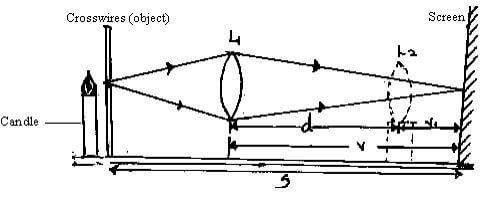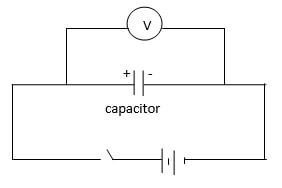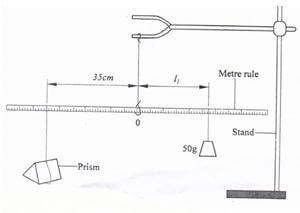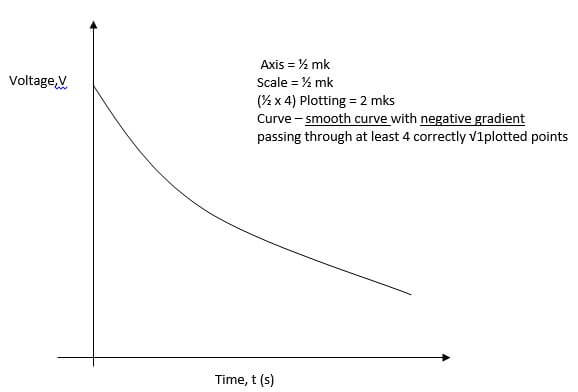INSTRUCTIONS TO CANDIDATES
- Write your name and admission number in the spaces provided above.
- Sign and write the date of examination in the spaces provided above.
- Answer ALL the questions in the spaces provided in the question paper.
- You are supposed to spend the first 15 minutes of the 2½ hours allowed for this paper reading in the whole paper carefully before commencing your work.
- Marks are given for a clear record of the observations actually made, their suitability, accuracy and the use made of them.
- Candidates are advised to record their observations as soon as they are made.
- Non-programmable silent electronic calculators may be used.
- Candidates should check the question paper to ascertain that all the pages are printed as indicated and that no questions are missing.
- Candidates should answer the questions in English.

QUESTIONS
Question One
- You are provided with the following apparatus;
- A candle (source of light illuminating cross wires mounted on a circular hole)
- A convex lens
- A lens holder
- One meter rule
- A whole screen
- Set the apparatus as shown in the diagram below

Illuminate the object cross wires using the candle provided when the distance between crosswires and screen S = 60cm.
By moving the lens away from the crosswires obtain a focused clear image of the object (crosswires) on the screen. Measure and record the distance V, between the lens position L1 and the clear image on the screen.
Keeping the distance S fixed i.e. S = 60cm move the lens further away from the object until another sharp image but diminished image of the cross wires is obtained on the screen. Measure and record the distance between the new lens position L2 and the sharp diminished image. Record this as V1. Repeat the procedure for other values of S shown in the table.- Complete the table (8marks)
S (cm) 60 65 70 75 80 85 90 V (cm) V1 (cm) d = V - V1 (cm) S2 (cm2) d2 (cm2) S2 - d2 (cm2) - Plot a graph of s2 – d2 against S (5marks)
- Determine the gradient (k) of the graph (3marks)
- Given that K =4f where f is the focal length of the lens used, determine the value for f. (2marks)
- State the advantage the method used above to determine the focal length of a lens has over the other methods. (1mark)
- Focus the window frame or any distant object and obtain a rough estimate of the focal length of the lens. (1mark)
- Complete the table (8marks)
Question 2
This question consists of two parts, A and B. Attempt both parts.
Part A
You are provided with the following
- A voltmeter
- A capacitor
- A switch
- A stopwatch
- Five connecting wires
- Two cells and a cell holder
Proceed as follows;
- Connect the circuit as shown in the figure below.

Ensure the terminals of the capacitor and those of the battery are correctly connected. (Positive to positive and negative to negative) - Close the switch, read and record the maximum voltage Vo across the capacitor.
Vo = _____________________________________________________________ volts. [1 mark] - While the voltmeter shows the maximum voltage Vo open the switch and start the stopwatch simultaneously. Stop the stopwatch when the voltage has dropped from Vo to 2.5V. Read and record in the table 2 the time taken.
- Reset the stopwatch and close the switch. Repeat the procedure in (c) to measure and record the time taken for the voltage to drop from Vo to each of the other values shown in table 2. ( 3marks)
Table 2
|
Voltage (V) |
2.5 |
2.25 |
2.0 |
1.75 |
1.50 |
1.25 |
|
Time, t(s) |
e)
- On the grid provided, plot a graph of voltage, V (y-axis) against time, t. [4 marks]
- Use the graph to determine the time, t at which V = Vo⁄2
t= ______________________________________ seconds [1 mark]
f) Determine the resistance R of the voltmeter given that t = 0.693 CR where C is the capacitance of the capacitor. [1 mark]
Part B
You are provided with the following;
- A triangular glass prism
- A metre rule
- A 50g mass
- Some hot water
- Some cold water
- Some thread
- A thermometer
- One stand, one boss and one clamp
- A beaker
Proceed as follows;
g) Using a piece of thread suspend the metre rule from the clamp on the stand and adjust the position of the thread until the metre rule balances horizontally. Note this position, O of the thread. (This position of the thread must be maintained throughout the experiment).
h) Using another piece of thread suspend the glass prism from the metre rule at a point 35cm from O. Suspend the 50g mass on the opposite side of O using another piece of thread. Adjust the position of the thread attached to the 50g mass until the metre rule balances once more.
- Determine the distance L1, between O and the point of support of the 50g mass.
L1 = ________________________________________ cm [1 mark] - Use the principle of moments to determine the weight W1 of the prism in air.
(Take g = 10N/kg) [1 mark] - Put cold water into the beaker (approximately 3⁄4). With the prism at 35 cm from O, determine the distance L2 of the 50g mass at which the rule balances when the prism is fully submerged in cold water.
- L2 = ________________________________________ cm [1 mark]
- Determine the weight W2 of the prism in cold water. [1 mark]
j) Measure and record the temperature T, of the cold water when the system is balanced.
T1 = _____________________________________oC. [1 mark]
k) Now pour out the cold water and replace with hot water. Balance the metre rule with the prism fully submerged in hot water. (Ensure that the prism is still supported at 35 cm from O)
- Determine the distance L3 of the point of support of the 50g mass when the prism is submerged in hot water.
L3= ______________________________________________________________ cm [1 mark] - Measure and record the temperature of the hot water.
T2 = ______________________________________________oC. [1 mark] - Determine the weight W3 of the prism in hot water. [1 mark]
l) Determine the constant k for the water given that [2 marks]
K= (W1 – W2) – (W1 – W3)
(W1 – W3) (T2 – T1)

MARKING SCHEME
QUESTION ONE .
|
S |
60 |
65 |
70 |
75 |
80 |
85 |
90 |
|
V |
38.0 |
44.0 |
50.0 |
55.5 |
61.0 |
67.0 |
72.5 |
|
V1 |
22.5 |
22.0 |
20.0 |
19.5 |
19.0 |
18.0 |
17.5 |
|
d = v-v1 |
15.5 |
22.0 |
30.0 |
36.0 |
42.0 |
49.0 |
55.0 |
|
S2 |
3600 |
4225 |
4900 |
5625 |
6400 |
7225 |
8100 |
|
d2 |
240.3 |
484.0 |
900.0 |
1296.0 |
1764.0 |
2401.0 |
3025.0 |
|
S2 – d2 |
3359.7 |
3741.0 |
4000.0 |
4329 |
4636.0 |
4824.0 |
5075.0 |
- Award a mark for any values of greater than 5
- Award no mark less than 5
- Award a mark of any values f v1 more than 5
- d = v0 – v1 any five or more values
- s2 values award mark is ≥ 5
- d2 values award mark is ≥ 5
- s2 – d2 values award mark is ≥ 5 max = 8marks
ii) Check for:
Labelled axis (1 mark)
Scale (simple/uniform/accommodative) ( 1 mark]
Plotting (at least 4 points) ½ x 4 = (2 mks)
Straight line (1 mark)
iii) Exact gradient = used shown
(5200-0)/(85-0) = 61.176
iv) K = 61.176
f = 61.176/4 = 15.29 = 15.0cm
v) Can be used to give a focal length value for inaccessible lens.
vi) Rough value for f = 15.5cm
QUESTION 2
PART A
b) Vo = 3.1 V √1 (min 1 dp)
d) Table 2
|
Voltage (V) |
2.5 |
2.25 |
2.0 |
1.75 |
1.50 |
1.25 |
|
Time, t (s) |
1.63 |
2.66 |
3.95 |
4.82 |
6.67 |
7.93 |
Each value ½ (½ x 6 = 3 mks)
e)i)
ii) V=Vo = 3.1 = 1.55V
2 2
t = 6.2 seconds →shown on the graph √½ within one small square
Correct reading √½
f) R = t = 6.2 x 106
0.693C 0.693 x 2200 (√½)
= 4066.64Ω
= 6.2 (√½ ) = 4066 Ω
0.693 x 2200 x 10-6
h) i) L1 + 47.4 cm + 10cm
ii) weight of the 50g mass 0.5N x 47.4 = W1 x 35
100 100
=50kg x 10N/kg
1000 (0.5 x 0.474)Nm = (0.35W1)Nm
=0.5N W1 = 0.5 x 0.474
0.35
W1 = 0.6771 N
Check for; - correct working for W1 in N *g must be used, either the letter g or 10N/kg
Correct evaluation ½ mk
W1 must be in Newton (N)½ mk
h)iii)(I) L2 = 28.0 cm + 5cm (1 dp)
(II) W2 = 0.28 x 0.05 x 10 - correct working for W2 in N *g must be used
0.35 - correct evaluation ½ mk
= 0.4N - W2 must be in Newtons (½ mk)
j) T1 = 31oC + 5 - correct to the nearest whole number
k) (i) L3 = 28.5 cm + 5 ( 1 dp)
ii) T2 = 83 oC + 5 (1dp)
iii) W3 = 0.285 x 0.05 x 10
0.35
= 0.41N
l) (0.6771 – 0.4) – (0.6771 – 0.41)
(0.6771 – 0.41)(83 – 31
= 0.2771 – 0.2671
0.2671 x 52
= 0.01 = 7.1998 x 10-4K-1
13.8892
Check for: - correct substitution (1 mk)
- correct evaluation (to at least 3. Sf)
- units required (1 mk)

CONFIDENTIAL
- A biconvex lens of focal length 15cm
- A lens holder
- A metre rule
- A white screen
- A candle illuminating crosswires mounted on a circular hole
- A matchbox
- A voltmeter (0-5V range)
- a 25V, 2200 µf capacitor (Terminals should be labeled for candidates)
- A switch
- Five connecting wires, two with crocodile clips
- Two new size D dry cells with a cell holder
- Some cotton thread – 1m long (1 piece), 0.5m long (2 pieces)
- Triangular prism(approximately 3.8 cm x 3.8 cm equilateral 60º,60º,60º)
- A metallic 50g mass
- Hot water (provide a pool of boiling water to be shared)
- Cold water (tap water)
- Plastic Beaker (at least 250 ml)
- Thermometer -10oC to 110ºC
- A stopwatch
- A metre rule
- A stand, boss and clamp
Download Physics Paper 3 Questions and Answers - Asumbi Girls Highschool Pre-Mock Exams May-June 2022.
Tap Here to Download for 50/-
Get on WhatsApp for 50/-
Why download?
- ✔ To read offline at any time.
- ✔ To Print at your convenience
- ✔ Share Easily with Friends / Students

